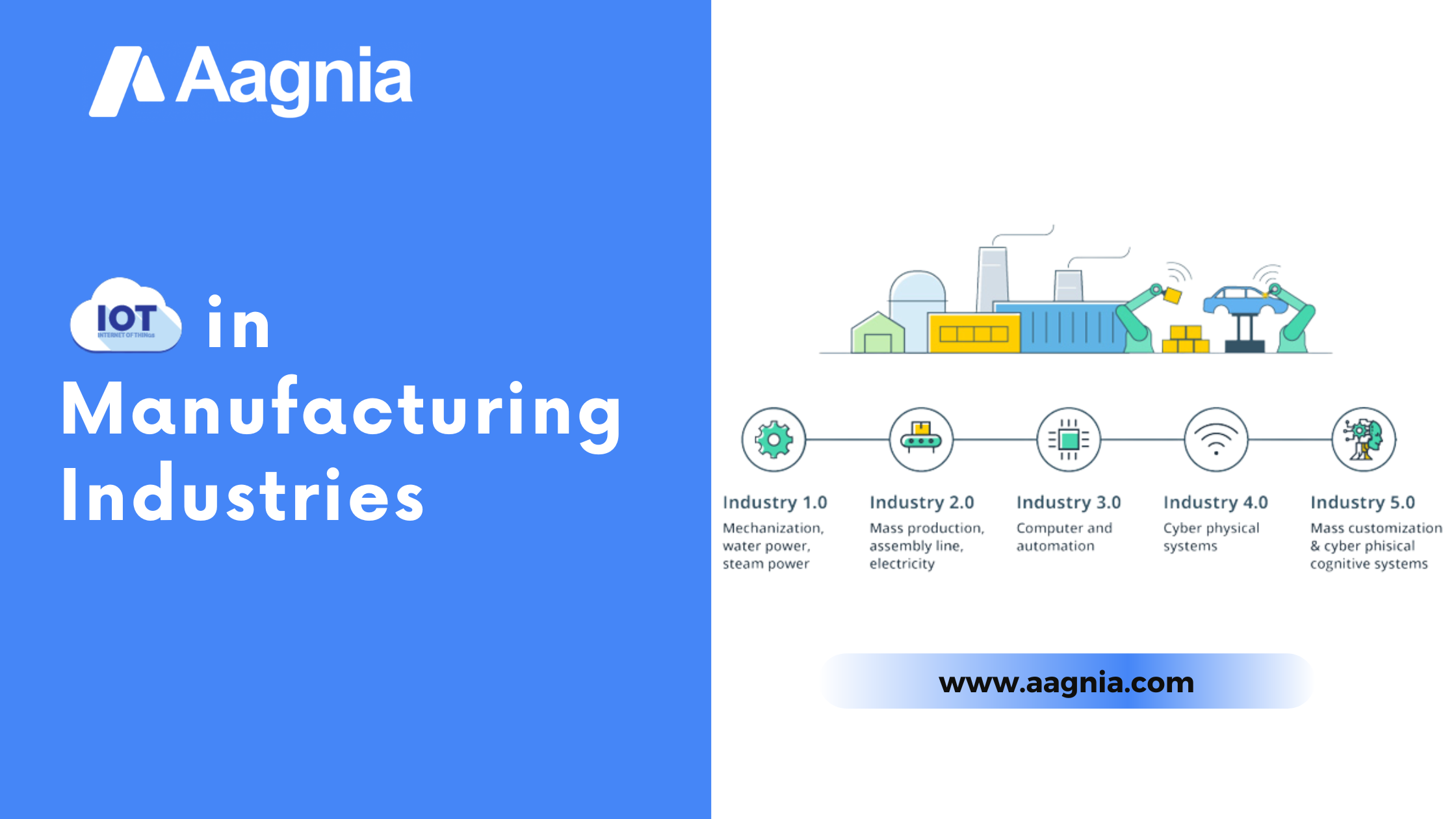
IoT in Manufacturing Industries
With IoT in Manufacturing Operations, you can improve customer experience and drive business growth:
The Industrial Internet of Things (IIoT) is a method for digital manufacturing transformation. Industrial IoT collects critical production data using a network of sensors, which is then turned into useful insights about the efficiency of manufacturing operations using cloud software.
Adoption of IIoT in Manufacturing:
The following are the primary adoption drivers for Industrial IoT solutions:
Cost reduction:
Companies minimise operational expenses and generate new revenue streams through improved asset and inventory management (resulting in lower inventory carrying costs and search times), less machine downtime, more agile operations, and more effective energy use. Smart, linked products, for example, make it possible to shift from selling products to selling experiences — product consumption and after-sale services.
Shorter time-to-market:
Reduced product cycle time is possible thanks to faster and more efficient manufacturing and supply chain activities. For example, Harley-Davidson used IoT to restructure its manufacturing facility in York, Pennsylvania, reducing the time it takes to make a motorcycle from 21 days to 6 hours.
Mass customization:
The mass customization process necessitates a considerable increase in the variety of manufactured SKUs, resulting in an increase in inventory and diversification. Manufacturing activities become increasingly sophisticated as well – the manufacturing of 20 SKU X goods can be followed by the creation of 10 SKU Y things in a matter of seconds. Tracking inventory and manufacturing processes becomes time-consuming and, in some cases, impossible. By providing real-time data for smart forecasting, shop floor scheduling, and routing, the IIoT makes mass customisation easier.
Improved safety:
The IIoT contributes to a safer workplace. When combined with wearable devices, the IIoT provides for the monitoring of workers’ health and potentially dangerous actions. IIoT addresses safety issues in potentially dangerous locations in addition to protecting worker safety. For example, in the oil and gas industry, IIoT is used to trace gas leaks as they travel through the pipeline network.
For a variety of reasons, analysts believe manufacturing will continue to lead until at least 2022. IoT has the potential to usher in a new industrial revolution – Industry 4.0 – by enabling manufacturers to implement digital transformation in a variety of ways, including automation, visibility, customer-centricity, and shorter time to market.
Let's take a look at the top six IoT usage, applications, and benefits in the manufacturing industry.
Quality Control:
Manufacturers make an item, their quality control unit tests it, and they expect to identify and correct problems before the product reaches the market in a normal reactive quality control procedure.
With thermal and video sensors gathering entire product data throughout the life cycle, IoT makes this procedure proactive. The items can also be evaluated at each stage of production to ensure that their characteristics are within standards. Furthermore, production equipment instrumentation and monitoring assist quality control employees in determining if and when equipment calibration deviates from standard settings – such inaccuracies must be detected early to minimise product misalignment.
Manufacturers may be more confident in spotting quality problems at the source thanks to IoT’s support in monitoring both equipment settings and the outcomes of each manufacturing step. As a result, incremental improvements can be made over time.
Inventory Management:
Inventory management becomes more effective and seamless when IoT is combined with radio frequency identification (RFID). Every item in the inventory has an RFID tag with a unique identification number (UID) that contains encoded digital data. RFID readers may read the tags, and the information retrieved is sent to the cloud for processing.
The job of industrial IoT in this case is to turn the data collected by RFID readers into actionable business insights. It keeps track of inventory items’ whereabouts, statuses, and movements along the supply chain, and provides users with comparable outcomes.
IoT-based inventory management architecture, for example, can determine the volume of raw materials necessary for a forthcoming manufacturing cycle based on data on inventory quantity and location.
IoT-based inventory management’s outputs can be used in a variety of ways. If any individual inventory item is missing, the system can send users an alert and warn them when the materials need to be replenished.
IoT provides supply chain managers with cross-channel visibility, including a realistic estimate of available materials, fresh material arrivals, and work-in-progress, allowing them to optimise shared costs across the value chain.
Manufacturers can better prepare to receive raw materials by measuring their pace of movement and traffic flow. This reduces handling times and allows for more efficient processing of those materials in the manufacturing process.
Predictive Maintenance:
Manufacturers have always used a time-based approach to planning their machinery and equipment maintenance plans. However, according to a research by the ARC group, just 18 percent of equipment fails due to age, whereas 82 percent of failures happen at random. This demonstrates that a time-based approach is inefficient and, in the long run, costly.
Using industrial IoT and data science for predictive maintenance, manufacturers can avoid ineffective maintenance routines. They can monitor the equipment’s operational environment and do analytics utilising associated data in the cloud to analyse the actual wear and tear by employing IoT sensors (on the equipment). Prompt service and repair results in increased maintenance efficiency, better job allocation to field workers, and less downtime, as well as significant cost savings.
Steel mills, for example, have many furnaces with temperature control provided by water cooling panels. Any leaks in the panels can cause safety concerns as well as a loss of productivity. Plant managers can utilise IoT-based predictive maintenance to strategically identify anomalies and conduct a root cause study to avoid machine failures and production delays.
More Safety in Operations:
IoT improves the safety of personnel, equipment, and operations in a manufacturing plant when used in conjunction with big data analytics. It can be used to measure key performance indicators (KPIs) such as employee absences, vehicle mishaps, machinery damage, and any other occurrences that disrupt routine operations.
In this instance, IoT wearables are crucial solutions. Employees who use these devices can also have their health parameters tracked continually while working in industries and fields. It allows them to assess their exposure to process fumes, stress levels, heart rate, fatigue, and overall movement. The information gathered can help companies improve their compliance structure and cut their insurance prices.
IoT can raise security risks if there are a variety of providers and security standards, as well as a lack of standardisation. Manufacturers who use IoT must connect their operations technologies and IT infrastructure to avoid their assets being attacked by malicious attackers. They should also plan their BYOD policy to ensure that personal gadgets do not interfere with industrial activities. In this case, cloud and IoT services provider support is important.
Smart Metering:
Smart metres that can monitor water, electric power, and other fuels have also been brought to the manufacturing sector, utilities, and other businesses thanks to the Internet of Things. IoT sensors enable businesses to assess specific consumption and adopt best practises for more efficient resource allocation.
Manufacturers can thoroughly analyse the findings of smart metre monitoring using customizable end-user dashboards provided by IoT services vendors. They can also analyse the costs, efficiencies, and carbon impact of various resources in order to better incorporate them into their manufacturing processes.
Smart Packaging:
For producers, smart packaging that directly uses materials with embedded interconnectivity gives advanced IoT benefits. One of the most important features of smart packaging is that it allows consumers to interact with it while also generating data that can be used to better manage a product. Smart packaging might include culinary videos, beauty tips, and other demos to illustrate how to use the product.
Sensors, QR codes, and augmented reality/virtual reality/mixed reality choices all function together in different ways with IoT and packaging. The goal is to provide added value to customers while simultaneously collecting data (through smart tracking) to improve operations and efficiency.
We design IoT solutions for a variety of industrial operations at Aagnia Technologies. Our team works together to install bespoke tools, linked devices, and connected processes that help clients get the most out of emerging technology.
Call us at +91 75400 07581 to learn more about our IoT solutions for manufacturers.
Join our news Letter
- Revolutionizing Parking Management A Real-Time Example
- The Importance of Regular Application Maintenance
- Logistics Software Solutions and Software Development
- Software Development Services for SMEs
- How Does IoT Aid Businesses in a Variety of Industries
- But what exactly is IoT – What does it mean for manufacturers – How can you use IoT to improve your business
- How to outsource custom software development Services
- 5 Reasons Why You Need To Outsource Software Development
- Why You Need A Cloud Strategy
- The Cloud Is Changing Everything, Here’s How To Make It Work For Your Business


